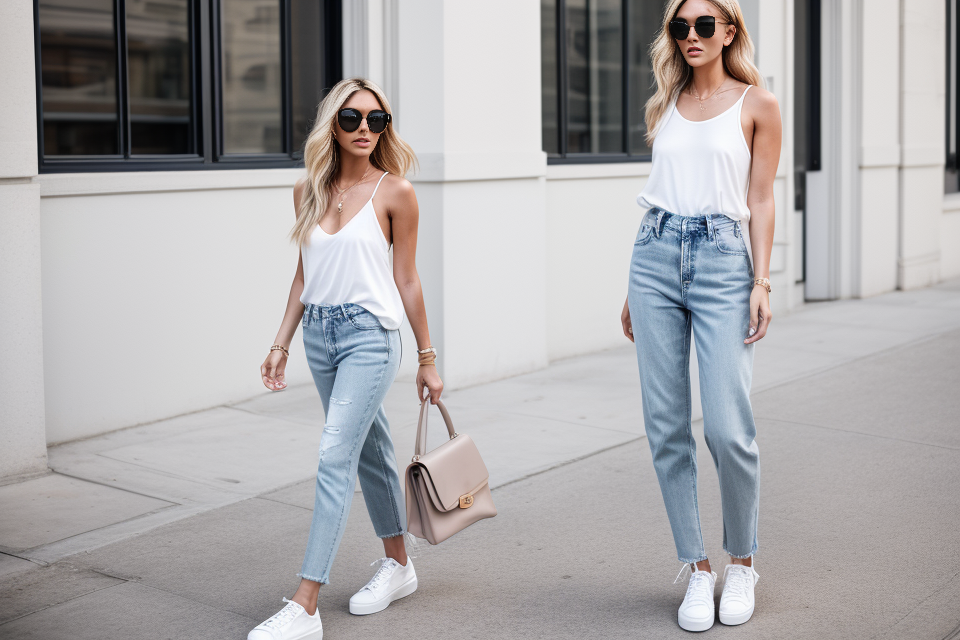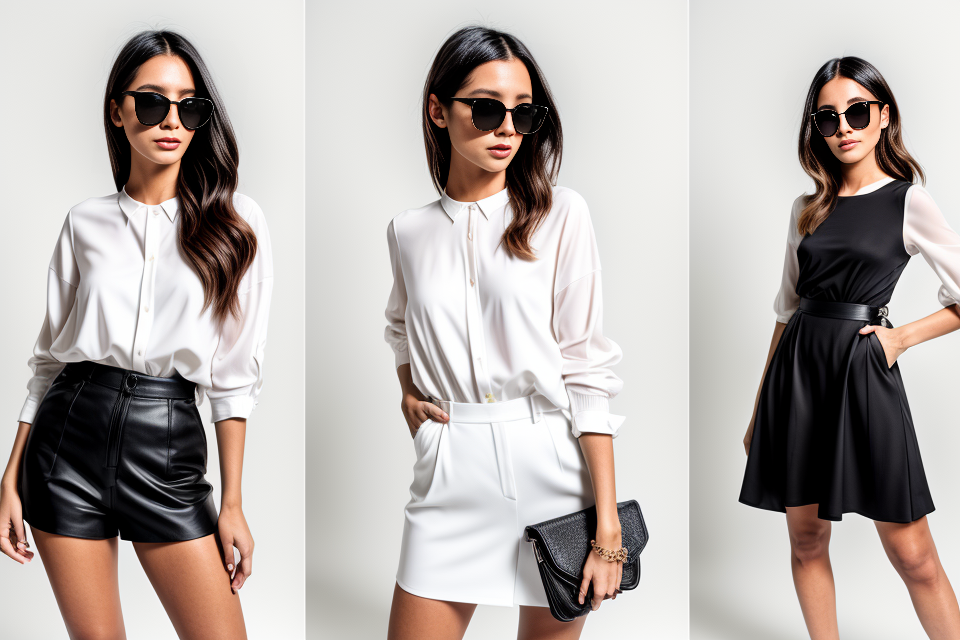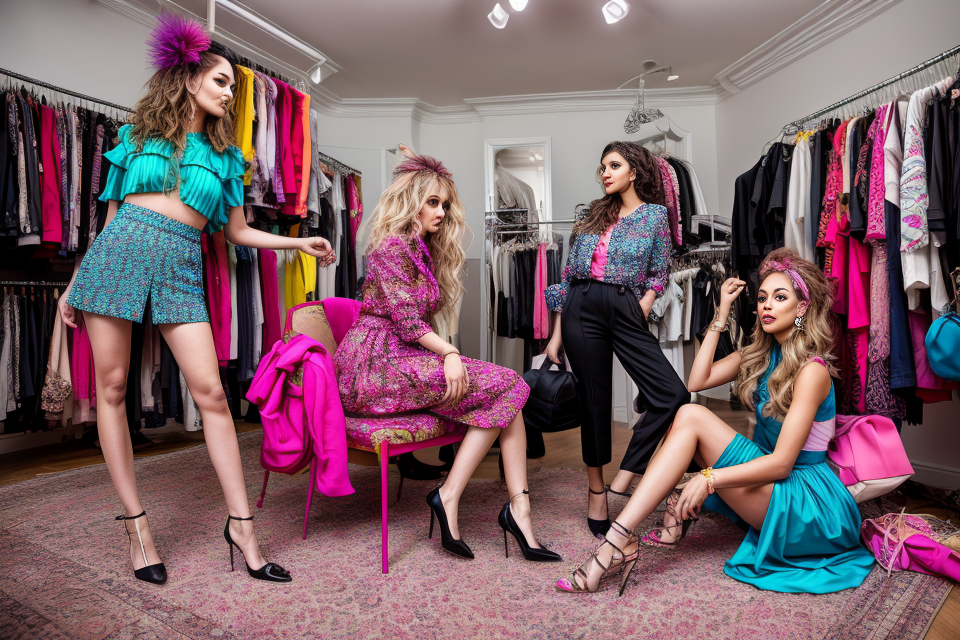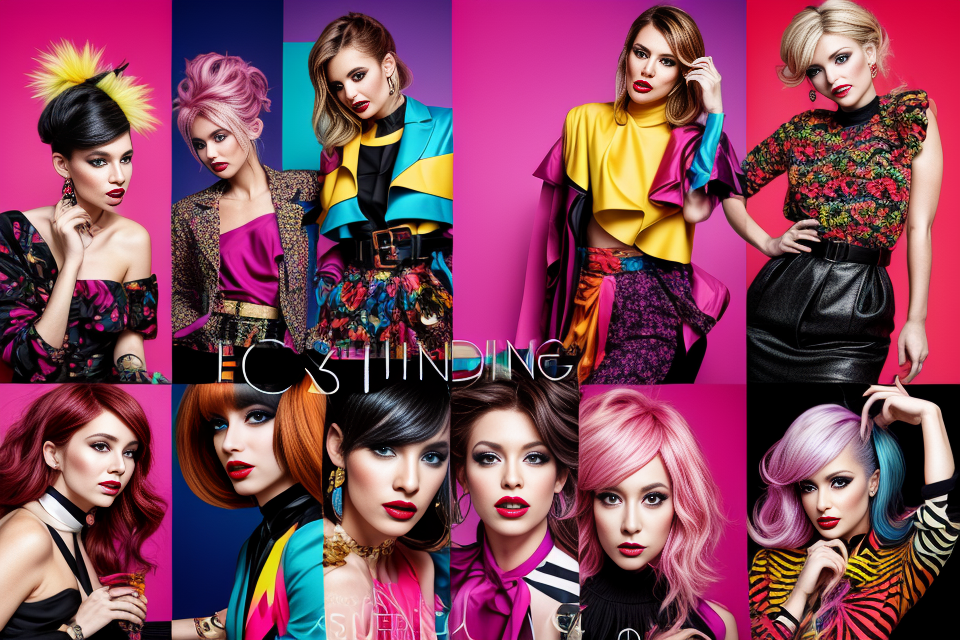
Fashion and fashion styling may seem like interchangeable terms, but they have distinct meanings in the world of fashion. Fashion refers to the trends and styles that are popular at a particular time, while fashion styling refers to the art of creating a specific look or image for a person or product. In this article, we will explore the difference between fashion and fashion styling and how they both play a role in the fashion industry. Whether you’re a fashion enthusiast or a budding stylist, understanding the difference between these two concepts is essential to succeeding in the world of fashion.
What is Fashion?
The History of Fashion
Fashion has been a part of human culture for centuries, with roots dating back to ancient civilizations. Over time, it has evolved and adapted to societal changes, reflecting the values and beliefs of each era.
- Ancient Civilizations: Early fashion was influenced by practicality and religious beliefs. Ancient Egyptians, for example, wore linen clothing as a symbol of purity and modesty, while the Greeks and Romans favored flowing robes and intricate textiles.
- Middle Ages: During the Middle Ages, fashion was heavily influenced by the church and social hierarchy. Peasants wore simple, practical clothing, while nobles and royalty adorned themselves in opulent garments made from expensive fabrics and embellished with gold and jewels.
- Renaissance: The Renaissance period saw a revival of classical ideas and an emphasis on individualism. Art and fashion were influenced by the human form, with clothing designed to accentuate the body and showcase one’s wealth and status.
- Industrial Revolution: The Industrial Revolution brought about significant changes in fashion, as new manufacturing techniques allowed for mass production of clothing. This led to the rise of fashion icons and designers, who began to shape the direction of fashion trends.
- Modern Era: In the modern era, fashion has become a global industry, with designers and brands from around the world influencing one another and shaping the way people dress. Social media and technology have also played a significant role in the democratization of fashion, making it more accessible to a wider audience.
Throughout history, fashion has served as a reflection of societal values, artistic expression, and technological advancements. Understanding the history of fashion can provide insight into the evolution of personal style and the impact of fashion on culture.
Fashion as a Form of Self-Expression
Fashion can be considered as a form of self-expression, where individuals use clothing, accessories, and styling to communicate their personal identity and values to others. This form of self-expression can be influenced by various factors such as culture, socio-economic status, age, and personal preferences.
Individuals may use fashion to convey their personality, mood, or social status, and to create a certain image of themselves in the eyes of others. Fashion can also be used as a means of rebellion or non-conformity, where individuals may choose to wear clothes that are considered unconventional or provocative.
Furthermore, fashion can also be a reflection of societal and historical contexts. For example, certain fashion trends may emerge during times of social and political change, such as the hippie movement of the 1960s or the punk movement of the 1970s.
Overall, fashion is not just about aesthetics, but also about the emotional and psychological significance that clothing and accessories can hold for individuals. It is a form of communication that can convey complex messages about one’s identity, values, and beliefs.
What is Fashion Styling?
The Role of a Fashion Stylist
A fashion stylist is a professional who is responsible for creating a visual representation of a particular style or concept. They work closely with photographers, designers, and models to bring their creative vision to life.
One of the main responsibilities of a fashion stylist is to select clothing, accessories, and props that will be used in a photo shoot or fashion show. They take into consideration the theme or concept of the shoot, the target audience, and the desired aesthetic when making their selections.
In addition to selecting clothing and accessories, fashion stylists are also responsible for organizing and setting up the shoot. This includes working with the photographer to determine the lighting and composition, as well as coordinating with the models and hair and makeup artists.
Fashion stylists may work on a variety of projects, including editorial shoots for magazines, advertising campaigns, and runway shows. They must have a strong understanding of current fashion trends and be able to anticipate future ones in order to create looks that are both visually appealing and relevant.
Overall, the role of a fashion stylist is to bring a particular style or concept to life through the use of clothing, accessories, and props. They play a crucial role in the fashion industry, helping to create and communicate a particular aesthetic through their work.
The Process of Fashion Styling
Fashion styling is the art of creating a visual representation of fashion through the careful selection and arrangement of clothing, accessories, and props. It is the process of creating a specific look or style for a particular person, product, or event.
The process of fashion styling involves several key steps, including:
- Concept Development: This involves developing a concept or idea for the shoot, whether it be a particular theme, mood, or style.
- Research: Research is an important part of the styling process, as it involves finding inspiration, identifying trends, and selecting the appropriate clothing, accessories, and props.
- Sourcing: Once the concept and research have been established, the stylist will source the appropriate clothing, accessories, and props needed for the shoot.
- Fitting: Before the shoot, the clothing and accessories will need to be fitted to ensure they are the right size and fit for the model.
- Styling: This is the actual process of putting together the outfit and selecting the appropriate accessories and props.
- Shooting: The final step in the process is the shoot itself, where the model is photographed wearing the selected outfit and accessories.
Overall, the process of fashion styling is a complex and multi-faceted process that requires creativity, attention to detail, and a deep understanding of fashion and visual representation.
The Differences Between Fashion and Fashion Styling
Fashion as a Trend
Fashion is often considered a trend, which refers to a temporary and often superficial shift in style or taste. It is characterized by the emergence of new fashion items, colors, patterns, and styles that become popular among consumers for a limited period of time. These trends are often driven by a variety of factors, including celebrity culture, social media, and the fashion industry itself.
Fashion trends can be short-lived, and what is considered fashionable today may not be tomorrow. For example, the popularity of skinny jeans, crop tops, and chunky sneakers has waxed and waned over the past few years, and it is unclear what new trends will emerge in the future.
One of the challenges of fashion as a trend is that it can be difficult to keep up with the latest styles and trends. Fashion bloggers, influencers, and magazines often set the tone for what is considered fashionable, and consumers may feel pressure to keep up with the latest trends in order to fit in or appear current.
Another challenge of fashion as a trend is that it can be difficult to make long-term investments in clothing and accessories. If a trend changes quickly, consumers may find themselves with items that are no longer in style, which can be frustrating and expensive.
Overall, fashion as a trend is an important aspect of the fashion industry, but it is important to recognize that trends come and go, and it is important to consider long-term investments in clothing and accessories that will stand the test of time.
Fashion Styling as a Personalized Approach
Fashion styling is a personalized approach that focuses on creating a unique and individualized look for a person. Unlike fashion, which is a broader term that encompasses the entire industry, fashion styling is all about the personalization of style. A fashion stylist works closely with clients to understand their personal preferences, body type, and lifestyle, and then curates a wardrobe that reflects their unique personality and style.
Here are some key differences between fashion and fashion styling:
- Personalization: Fashion styling is all about personalization, whereas fashion is a broader term that encompasses the entire industry.
- Focus: Fashion styling focuses on creating a unique and individualized look for a person, whereas fashion focuses on the broader trends and styles within the industry.
- Goal: The goal of fashion styling is to help a person look and feel their best, whereas the goal of fashion is to create clothing and accessories that are appealing to a wider audience.
Overall, fashion styling is a highly personalized approach that involves working closely with clients to create a unique and individualized look. By taking into account a person’s personal preferences, body type, and lifestyle, a fashion stylist can help them feel confident and stylish in their own skin.
The Influence of Culture on Fashion
Culture plays a significant role in shaping fashion trends and styles. Different cultures have their unique traditions, beliefs, and values that influence the way people dress. For example, in some cultures, modesty and conservatism are highly valued, which translates to more covered-up clothing styles for both men and women. In contrast, other cultures emphasize individuality and self-expression, leading to more diverse and creative fashion styles.
Moreover, cultural exchanges and globalization have played a significant role in shaping the fashion industry. Designers and brands draw inspiration from various cultures, creating a fusion of styles that appeal to a broader audience. For instance, the use of African prints and patterns in Western fashion has become increasingly popular in recent years, showcasing the influence of different cultures on fashion.
In addition, cultural events and celebrations also have a significant impact on fashion trends. For example, traditional festivals and ceremonies often have specific dress codes that participants must follow, leading to the creation of unique and specific fashion styles. These styles are then adopted and adapted by fashion designers, becoming a part of the global fashion conversation.
Overall, the influence of culture on fashion cannot be overstated. It shapes the way people perceive and understand fashion, and it continues to play a crucial role in shaping the industry and trends.
The Relationship Between Fashion and Fashion Styling
How Fashion Influences Fashion Styling
Fashion and fashion styling are two concepts that are often used interchangeably, but they have distinct meanings and roles in the world of fashion. Fashion refers to the clothing, accessories, and beauty trends that are popular at a particular time and place. Fashion styling, on the other hand, refers to the art of creating a specific look or image using clothing, accessories, and beauty products.
Fashion has a significant influence on fashion styling. It provides the foundation for the stylist to work with. Fashion trends and popular styles dictate the types of clothing, accessories, and beauty products that are in demand. A stylist must stay up-to-date with the latest fashion trends to create looks that are relevant and appealing to their clients.
In addition to being aware of current fashion trends, stylists must also have a deep understanding of the history of fashion. This allows them to draw inspiration from past styles and adapt them to modern tastes. For example, a stylist may draw inspiration from the 1920s flapper style and adapt it to create a modern, sophisticated look.
Furthermore, fashion influences fashion styling by setting the tone for the types of colors, patterns, and materials that are popular. For instance, a trend towards bold, bright colors may influence a stylist to choose vibrant hues for their clients’ outfits.
In conclusion, fashion plays a crucial role in shaping fashion styling. Stylists must stay informed about current fashion trends, understand the history of fashion, and be aware of the types of colors, patterns, and materials that are popular to create looks that are relevant and appealing to their clients.
How Fashion Styling Influences Fashion
Fashion styling plays a significant role in shaping the fashion industry. It influences fashion trends, dictates the way clothes are presented, and impacts consumer behavior.
- Trend Forecasting: Fashion styling is often used to forecast upcoming trends. Stylists keep a close eye on the runway shows, street style, and popular culture to predict which styles and colors will be in vogue in the coming seasons. This information is then used by fashion designers, retailers, and manufacturers to create new collections.
- Presentation: Fashion styling is also responsible for the way clothes are presented to the public. Stylists work with photographers, models, and fashion editors to create editorial spreads, advertising campaigns, and runway shows that showcase clothing in the most visually appealing way possible. These presentations have a significant impact on how consumers perceive and buy fashion.
- Consumer Behavior: Fashion styling can also influence consumer behavior. Stylists use their knowledge of fashion trends and consumer preferences to create looks that are both desirable and attainable. By highlighting key pieces and showing how they can be mixed and matched, stylists encourage consumers to buy more clothes and experiment with their wardrobes.
Overall, fashion styling is a powerful tool that shapes the fashion industry in many ways. It influences what we wear, how we wear it, and what we buy. As such, it is an essential part of the fashion ecosystem and cannot be overlooked.
The Importance of Understanding the Difference
- Clearer Distinctions
- The distinction between fashion and fashion styling is crucial to provide a clearer understanding of the roles each plays in the fashion industry.
- This helps to differentiate between the creative and commercial aspects of fashion, allowing for a more comprehensive analysis of the industry’s dynamics.
- Efficient Resource Allocation
- Understanding the difference between fashion and fashion styling can lead to more efficient resource allocation within the industry.
- For instance, fashion designers can focus on creating unique and innovative designs, while fashion stylists can concentrate on showcasing the designs through their styling choices.
- Better Communication
- Knowing the difference between fashion and fashion styling facilitates better communication among professionals in the industry.
- It enables designers, stylists, and other fashion professionals to communicate their ideas and intentions more effectively, leading to improved collaboration and overall better results.
- Informed Consumer Decision-Making
- Understanding the difference between fashion and fashion styling can also benefit consumers by helping them make more informed decisions about their purchases.
- By recognizing the unique contributions of fashion and fashion styling, consumers can better appreciate the value of both and make more educated choices when it comes to fashion products and services.
- Evolving Industry Trends
- As the fashion industry continues to evolve, understanding the difference between fashion and fashion styling becomes increasingly important.
- Recognizing the distinct roles and contributions of each can help industry professionals adapt to changing trends and stay ahead of the competition.
FAQs
1. What is fashion?
Fashion refers to the style or styles of clothing, footwear, accessories, makeup, and hairstyles that are popular at a particular time or place. It is a form of self-expression and can be influenced by various factors such as culture, history, social class, and individual preferences.
2. What is fashion styling?
Fashion styling is the art of creating a look or outfit by combining different elements such as clothing, accessories, and beauty products. It involves selecting and arranging items to create a desired image or style, which can be used for fashion photography, editorials, advertising, or personal styling.
3. What is the difference between fashion and fashion styling?
Fashion refers to the overall trend or style of clothing and accessories, while fashion styling refers to the specific way in which those elements are arranged to create a look or outfit. Fashion is more concerned with what is popular or trendy, while fashion styling is more focused on creating a unique and personalized look.
4. Can fashion styling be considered a form of art?
Yes, fashion styling can be considered a form of art as it involves creativity, imagination, and a sense of aesthetics. Like other forms of art, fashion styling can be used to express emotions, tell a story, or convey a message.
5. Who can be a fashion stylist?
Anyone can be a fashion stylist! It doesn’t require any formal education or training, although some people may choose to pursue courses or certifications to improve their skills. Fashion styling is a highly competitive field, and success often depends on talent, creativity, and a strong portfolio.


